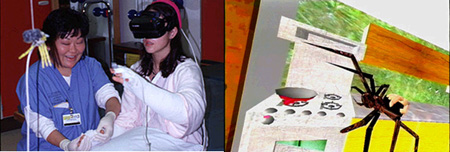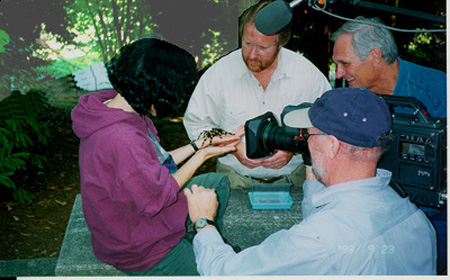|
|
Hunter HoffmanCognitive Psychology/Research Scientist/ Specializing
in using VR to reduce Smithsonian exhibit of SnowWorld opens Dec 8th, 2006 Department of Mechanical
Engineering
|
|
As an undergrad atthe University of Tulsa, Hunter studied memory with Pawel Lewicki, magical thinking with Leonard Zusne (foreshadowing Hunter's later interest inVR)and bio-electromagnetics with Dr. O'Connor (foreshadowing Hunter's current interest in fMRI). Prior to grad school, Hunter then spent a year conducting memory research with Marcia Johnson at Princeton University on "reality monitoring": How people separate memories of real from memories of imagined events. And he studied perception using "illusory conjunctions"with Bill Prinzmetal. Marcia helped him get into graduate school at the University of Washington in Seattle where he worked with legendaryeyewitness memory expert Elizabeth Loftus, famous for her research on the malleability of human memory for crimes, accidents, and childhood events, e.g., memory distortions caused by information encountered afterthe memory was formed. In grad school, he also studied the relation betweenattention and memory with Geoff Loftus, which influenced his future research in VR analgesia. Hunter received a Ph.D. in Cognitive Psychology (human memory and attention) at the U.W. in 1992, and did post-doctoral research on social influences on memory with Larry Jacoby in Canada. In 1993Hunter returned to Seattle, and began virtual reality research at the University of Washington Human Interface Technology Laboratory in Seattle, one of the largest VR research laboratories in the world. This laboratory was founded and is directed by Professor Tom Furness, one of the fathers of virtual reality (Dr. Furness formerly headed the Air Force Supercockpit project). Current Research interests: Use of VR for distracting burn patients from excessive pain during wound care (in collaboration with Dave Patterson, burn research nurse Gretchen Carrougher from Harborview Burn Center, and with Sam Sharar, M.D.). Burn wounds are often extremely painful, especially when the wounds are being cleaned to prevent infection or when stretching the newly healing skin during physical therapy. Our interdisciplinary team is putting burn patients (especially children and teenagers) into VR during wound care and physical therapy. Although this line of research is just beginning (with funding from NIH, the Paul Allen Foundation),we are already finding huge drops in how much pain the patients experience during their short visit to virtual reality (see www.vrpain.com).
Presence and physically touching virtual objects. Virtual Reality exposure therapy for treating Spider Phobia.
VR exposure therapy for Post-Traumatic Stress Disorder from Sept11th. In collaboration with PTSD expert JoAnn Difede from CornellPresbyterian Hospital in Manhattan, Hunter, Howard Abrams, and DuffHendrickson recently created a virtual world called "World TradeCenter" world, to successfully treat survivors of Sept 11th who havedeveloped post-traumatic Stress Disorder (click here to download manuscript). Water-friendly VR helmet. Hunter designed a fiberopticVR helmet that can be worn while the patient sits in a tub of water(with his/her head not in the water). Only photons, no electrons,reach the subject's head. Jeff Magula and Hunter recently builtthis helmet, which is now being used in collaboration with Dave Pattersonat Harborview Burn Center to treat burn patients with virtual reality during wound care in a hydrotank (see the Journal of Clinical Psychology in Feb04). Magnet-friendly VR helmet. In collaboration with fMRIexpert Todd Richards (Professor in Radiology) and optical bioengineerEric Seibel, Hunter helped create a fiberoptic VR helmet that can beworn in an fMRI brain scanner. Jeff Magula helped design and he assembledthe helmet, which required a lot of creativity and skill on his part. CecilHayes and Mark Mathis (world class fMRI headcoil experts at the U.W.Radiology) built the custom fMRI headcoil that couples with the VR goggles. The result is a relatively high resolution, relatively wide field of view, easy to use fMRI VR helmet. It is now being used by about5 research teams at the U.W. Digital Imaging Sciences Center to delivervisual stimuli (not necessarily virtual reality) to patients and healthyvolunteers during fMRI Neuroscience brain scans (click here to download paper). ---------------------------------------------------------------------------------------
|
Last Modified: Friday March 24th, 2006, 17:58:39 PDT
Human Interface Technology Laboratory




